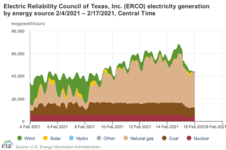I'm not arguing for or against "green energy." There are lots of good idea fairies there, and it distracts from the topic of this thread. The trade offs and draw backs have little to nothing to due with the current problem and only serve to distract from actual solutions to the issue at hand (solutions that may or may not be worth the price).
Texas consumes more power than any other state in the nation, scale will always be an issue.
The point that wind turbines can still generate power in the cold still stands. North Dakota gets about the same percentage of its power from wind as does Texas, and it is currently exporting power to southern states. Texas is down 28,000 megawatts from natural gas, coal, and nuclear plants that are off line. It is down 18,000 megawatts from solar and wind. Solar and wind account for 28.6% of the states generation capacity, so corrected for generation capacity for each method solar and wind are down more as they account for 39% of lost capacity. Those numbers also makes it vary clear that the issue is much broader.
The hilarious thing is I never argued that wind was a good investment. I'm not really a fan of wind power for several reasons. However, it is failure to prepare, not "green" energy sources, that has Texas in its current predicament. The question of if it is worth the cost of preparing for rare events still stands. Not all risk is worth mitigating. Example, how many people are going to invest in a home natural gas generator and home underground natural gas storage as a result of this? Other than financial, what are the risks that come with doing so?
How much have Texans invested in natural gas? How much in coal? Without context that 42 billion is meaningless. I could not find good numbers, but I did find that the cost of modernizing Texas coal pants is 10 billion, so I'm willing to bet Texas just spends a lot on power infrastructure as it consumes more power than any other state.



